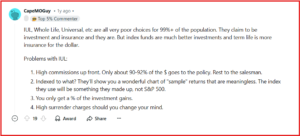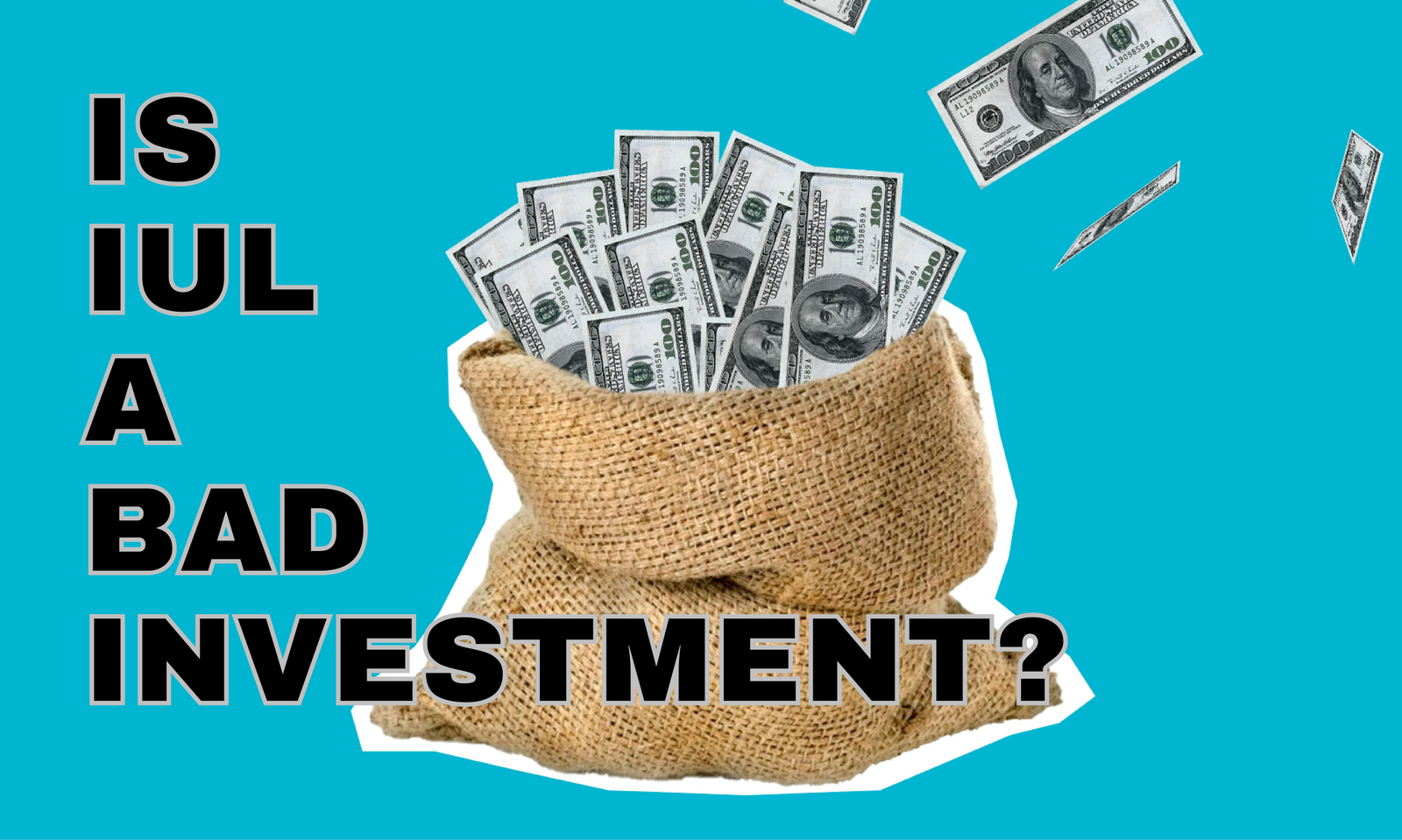Why IUL is a bad investment – This is a question that comes up often in our minds.
Indexed Universal Life (IUL) insurance may seem like a smart choice. for some. You get life insurance as well as a chance to grow your money tax-deferred.
Sounds great, right? But is it really worth it?
Before you make any decision, let’s take a deeper look at it.
In this post, I’ll guide you through:
- What an IUL policy is and how it works?
- Why do people consider IULs to be bad investments?
- When may IULs be appropriate for specific situations?
- Other options to help you meet your financial goals.
In the end, you’ll have a clear understanding of whether an IUL is the right choice – or if there’s a better way to grow your wealth. Let’s discuss it!
What is an IUL?
An Indexed Universal Life (IUL) policy is a life insurance plan that also allows you to grow savings.
The policy’s cash value grows based on a market index, such as the S&P 500, but is not directly invested.
This means you won’t lose money if the market falls, but your returns are capped by the insurer’s limits.
Here are the key features of an IUL policy:
- Tax-deferred growth: Your cash value isn’t taxed until you withdraw it.
- Flexible premiums: You can adjust the amount of your payment, making it easier to manage during financial fluctuations.
- Market-linked returns: Your cash value grows based on index performance, but with participation limits and rate caps.
Some people use a ‘max funded IUL’ strategy, where they pay more than the required premium to grow the cash value faster.
This minimizes the cost of insurance and maximizes potential growth, making it suitable to those seeking tax-free income through withdrawals or loans.
Why IUL Is a Bad Investment: Key Risks You Should Know
Indexed Universal Life (IUL) policy is often promoted as flexible and beneficial, but it also comes with a number of drawbacks. If you’re considering this, here are some key risks you should understand before going ahead.
1. High Fees and Hidden Costs

“Here’s what users say about IUL”
IUL policies come with a variety of charges, including administrative fees, mortality costs, and additional rider charges.
These costs are deducted from your premium payments and reduce the cash value available for growth.
Even with market-linked returns, frequent fees can reduce the overall value of your investment over time.
2. Complexity of the Product
IUL policies are not simple. Managing them requires an understanding of market index performance, premiums, and cash value accumulation.
Many policyholders struggle to deal with these complexities, increasing the risk of making mistakes such as underfunding.
If premiums are not managed properly, the policy may lapse, preventing you from receiving the promised benefits.
3. Limited Returns
While IUL policies are linked to market indices, they include caps and participation rates that limit your earnings.
For example, if the market rises 10% but your cap is 6%, you only get a portion of the increase.
When compared to direct market investments like a Roth IRA or 401(k), returns on IUL policies are often much less competitive.
4. Lack of Transparency in Marketing
An IUL policy is often sold as a low-risk and high-growth potential policy, but details of fees and caps are rarely emphasized.
This lack of transparency can lead to disappointment when actual returns do not match the promises made during the sales process.
5. Risks Associated With Loans
You can borrow against the cash value of your policy, but unpaid loans reduce the death benefit and can cause the policy to expire.
If the loan interest exceeds the cash value growth, this can cause significant financial stress or unexpected costs.
These risks make an IUL policy less suitable for those looking for direct investment options.
Situations Where an IUL May Work
Indexed Universal Life (IUL) insurance policies are not inherently bad. They can work well in specific financial situations.
1. High-Income Earners Seeking Tax-Free Growth
If you’re a higher-income individual and have maxed out retirement options like Roth IRAs and 401(k)s, an IUL policy could provide another way out.
It allows you to grow cash value on a tax-deferred basis, which could be appealing to someone trying to minimize taxes in retirement.
2. Investors With Long-Term Plans
IUL works best for individuals who have a long-term vision, typically 15-20 years. The early years can be costly because of fees and commissions, so commitment is important.
If you’re willing to stick with it, the policy’s cash value can grow significantly over time, although returns can vary.
3. When Max-Funding is the Strategy
A max funded IUL can help reduce insurance costs and maximize the policy’s cash value.
For example, people who contribute more than the minimum premium may get better returns over time.
While not for everyone, an IUL policy can be a strategic tool when used in the right circumstances and with a clear understanding of the costs involved.
IUL Alternatives to Consider
If you’re unsure about an IUL policy, there are simpler and often better alternatives available.
1. Term Life Insurance
Term life insurance provides straightforward protection. You pay a fixed premium, and your beneficiaries receive the payout if you die.
It is cost effective and easier to understand as compared to IUL. You can invest the money saved on premium somewhere else.
2. Roth IRAs and 401(k)s
These are great options for retirement savings. The Roth IRA offers tax-free growth, while the 401(k) offers pre-tax contributions.
Unlike the IUL policy, these plans are designed for investment, not insurance, and have fewer fees or limits.
3. Mutual Funds, ETFs, and Index Funds
If your goal is investment growth, then mutual funds, ETFs or index funds are better options.
These options are simpler, cost less, and provide more transparency than the complexity of IUL policies.
Here’s a quick comparison table:-
| Feature | IUL Policy | Roth IRA | Term Life Insurance |
|---|---|---|---|
| Purpose | Insurance + Investment | Retirement Savings | Pure Insurance |
| Cost | High Fees | Low Fees | Very Affordable |
| Returns Potential | Limited (Caps/Fees) | Market-Linked | Not Applicable |
| Tax Benefits | Tax-Deferred | Tax-Free Growth | No Tax Benefits |
| Complexity | High | Medium | Low |
By understanding these options, you can choose a financial product that best suits your goals and avoid unnecessary complexity.
If you’re unsure, consult a financial advisor to find out the best option for you.
To Sum Up
Understanding why IUL is a bad investment for many depends on its complexity, high costs, and limited returns. Although it has specific use cases, such as for high-income earners who want tax-free growth, it’s not a one-size-fits-all solution.
If you’re considering an IUL policy, take time to evaluate whether it fits your financial goals. Talking to a financial advisor can help you assess its advantages and disadvantages based on your situation.
Looking for more guidance? Check out our page for more financial strategies!
The content on this page is for informational purposes only and should not be considered financial, tax or investment advice. Each person’s financial situation is different, so be sure to consult a qualified financial advisor, tax professional or investment expert before implementing any strategy or product mentioned here. We do not endorse or recommend any particular strategy or product.


4 thoughts on “5 Reasons Why IUL Is a Bad Investment?”